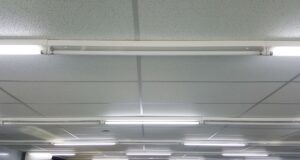How is Fluorescent Lighting Defined?
Fluorescent lighting is a very adaptable sort of lighting that you are likely to meet in the workplace, school, or supermarket. It is well-known for its superior energy efficiency over incandescent and halogen light bulbs and its cheaper price point than LEDs.
Fluorescent lighting comes in various forms, including linear fluorescent tubes, fluorescent circline tubes, fluorescent bent tubes, and compact fluorescent lamps (CFLs) (compact fluorescent lamps).
Due to their ubiquity, we’re going to concentrate on linear fluorescent tubes throughout this essay. Fluorescent tubes are often employed in commercial buildings above fixtures, like troffers.
What is the Operation of Fluorescent Lights?
Fluorescent lighting generates light by a chemical process within a glass tube. This chemical process includes the interaction of gases with mercury vapour, which creates an invisible ultraviolet light. UV radiation lights the phosphor material covering the interior of the glass tube, producing white “fluorescent” light.
The following is a more detailed description of the procedure:
- Electricity enters a light fixture through a ballast, such as a troffer. The ballast – which controls the voltage, current, and other parameters required for a fluorescent bulb to illuminate – supplies power to the fluorescent bulb’s pins on both ends.
- After passing through the pins, the electricity goes to the electrodes within the sealed glass tube, maintained at low pressure. Electrons begin their journey throughout the tube, going from one cathode to the next.
- Inert vapours and mercury are contained inside the glass tube and are stimulated by the electrical current. As electricity flows, the mercury vaporizes, and the gasses begin interacting to generate an invisible UV light that humans cannot see with the naked eye.
Why is Ballast Used for Fluorescent Lights?
A ballast’s main job is to change the alternating current that flows through your walls in waves, up and down, into a steady and direct stream of power. This helps to sustain and regulate the chemical reaction happening within the bulb.
Why Do Fluorescent Lights Change Color from Pink and Orange?
If you gaze up at the ceiling of a huge room that is largely lighted by fluorescent bulbs, there is a considerable possibility that you will see a rainbow of hues. Why?
This is referred to as “colour shifting.” The longer fluorescents burn, the more probable their chemical characteristics will vary, resulting in an unbalanced reaction, less white and less bright in the fluorescence.
If maintaining uniformity is critical for your lighting project, you may want to consider group relamping these bulbs. By changing all of the tubes in your room in batches, you may resolve the problem of uneven colour and brightness.
Applications For Fluorescent Lamps
 Fluorescent lighting is suitable for various applications, including industrial, commercial, and residential. Fluorescent illumination eliminates shadows in all situations.
Fluorescent lighting is suitable for various applications, including industrial, commercial, and residential. Fluorescent illumination eliminates shadows in all situations.
- Fluorescent bulbs provide a strong light output, ideal for illuminating vast areas and detailed work lighting in industrial applications.
- Fluorescents offer a consistent illumination level across an office area and are ideal for precise job lighting in commercial settings.
- In residential applications, they may also be utilized as uplighting from cabinets, beams, coves, and under-cabinet lighting. Fluorescent lighting is an efficient illumination source for kitchens, valences, cornices, and fascias.
- T8 fluorescents are the most often used in commercial and industrial applications.
- In sign and display applications such as jewelry shops, smaller fluorescent bulbs such as T5’s are employed.
- Ceiling fittings are often circular fluorescent light, common in residential applications.
What Benefits Makes Fluorescent Lighting Offer?
- Fluorescent lighting is 66% less expensive than incandescent lighting while giving the same brightness. When you consider that light bulbs account for around a quarter of a home’s electricity use, the savings may pile up quickly.
- Fluorescent bulbs have a longer lifespan. They burn less after prolonged use and may be turned on and off without fear of overheating. On average, a bulb or tube lasts six times as long as a conventional incandescent bulb.
- Because the lights emit no heat, they are ideal for area lighting and situations where extra heat might cause equipment to fail or discomfort users.
For the best Fluorescent lighting Installation installation services in the Surrey area, visit Gregg Electric online or speak with our friendly experts at (604) 557-4734 today.



